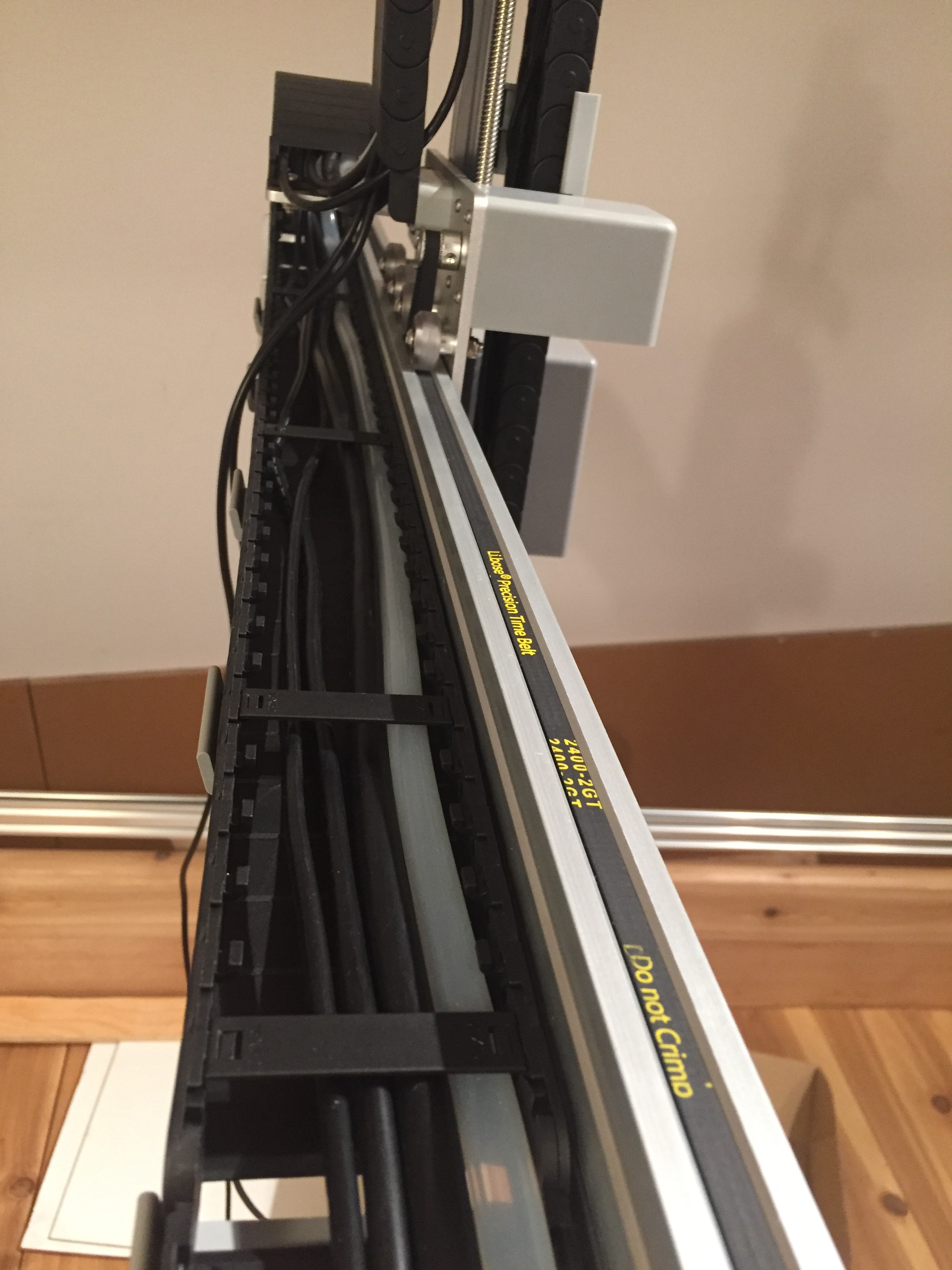Y-Axis Cable Carrier
- Step 1: Prepare the cable carrier
- Step 2: Orient the cable carrier
- Step 3: Add the y-axis motor and encoder cables
- Step 4: Lay out the tubing and wiring
- Step 5: Snap in some tabs
- Step 6: Mount the cable carrier to the cross-slide
- Step 7: Mount the cable carrier to the gantry
- Step 8: Snap in the remaining tabs
- What’s next?
Step 1: Prepare the cable carrier
Remove all of the snap-in tabs from the y-axis cable carrier. Note that the x-axis and y-axis cable carriers are the same length, so you can grab either one for this step.
Step 2: Orient the cable carrier
There is only one orientation that the y-axis cable carrier mounts to the cross-slide and gantry, and it is determined by the orientation of the end pieces. Lay the cable carrier onto the gantry’s horizontal cable carrier supports but do not attach it at this time.
Not pictured: The cables and tube coming from the z-axis cable carrier.
Step 3: Add the y-axis motor and encoder cables
Feed the y-axis motor and encoder cables through the slot in the cross-slide plate such that there is enough cable length so that they can be comfortably connected to the motor and encoder. Ensure you feed the correct end of the cables through the slot by checking the connection with the y-axis motor and encoder. However, do not keep them plugged in at this time as they can be damaged if pulled on.
Not pictured: The cables and tube coming from the z-axis cable carrier.
Photo of the Y-Axis motor wires. Use the Zip ties and plenty of slack to ensure the motor and encoder wires do not rub up against the belt.
Step 4: Lay out the tubing and wiring
Lay the y-axis motor and encoder cables, the water tube that is coming from the z-axis cable carrier, UTM cable, camera cable, vacuum pump cable, and the z-axis motor and encoder cables into the open y-axis cable carrier.
Organization is important!
When laying the cables and tube in the carrier, ensure that none of the cables or tube criss-cross over each other. If they do, you will have trouble snapping in the tabs and you risk compressing the tube and preventing water flow.
Step 5: Snap in some tabs
Snap in three cable carrier tabs at both ends of the cable carrier, and ten more spread throughout the middle of the cable carrier so that as you mount the assembly, the cables and tube will stay in place. You do not want to snap in all of the tabs at this time because that will make it difficult to adjust anything if needed.
Step 6: Mount the cable carrier to the cross-slide
Carefully flip over the end of the cable carrier such that the end piece is positioned on the long cable carrier mount. Make sure you maintain organization of the cables and tubing when doing this.
Reduce the amount of extra tubing and wiring between the end of the y-axis cable carrier and the z-axis cable carrier by gently pulling the extra length through the y-axis cable carrier. It can be difficult to coax the contents around the bend of the cable carrier, so take your time and ensure that you are not pulling anything too hard. Never pull anything by the connector.
Attach the y-axis cable carrier to the long cable carrier mount using two M5 x 16mm screws, M5 washers, and M5 locknuts.
Not pictured: The cables and tube.
Step 7: Mount the cable carrier to the gantry
Attach the y-axis cable carrier to the horizontal cable carrier support nearest the gantry using two M5 x 16mm screws, M5 washers, and M5 locknuts.
Not pictured: The cables and tube.

Y-Axis Cable Carrier with the Cables and Tubes
Step 8: Snap in the remaining tabs
Once everything is situated well, snap-in the remaining cable carrier tabs, ensuring that you maintain organization of the cables and tube.
Not easy to adjust
Once you snap-in the remaining tabs, it will become impossible to adjust anything without removing the majority of the tabs first. Make sure everything is in place before you make a bunch of extra work for yourself.